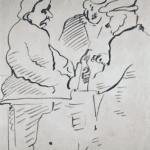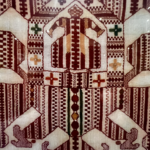The ikat silks of Central Asia
Above the merchant’s head is a page from the Koran. Behind him, piled to the roof, are rolls of Russian-printed cotton and ikat silks. A very elaborate process of resist-dying the yarn was employed to create intricate ikat patterns. Always in great demand, ikat silks of Central Asia were unique in their inventive designs and dazzling colors. In almost every household, women kept their own silkworms, raising them on mulberry leaves. Fabric production was the work of men. Textile guilds of Uzbek and Tadjik weavers and Jewish dyers were renowned for their extraordinary skills. In the late 19th century, as less expensive factory-produced Russian cotton prints flooded the markets of Central Asia, the craft began to decline.
The social role of ikat
This coat is made of ikat velvet. Valuable ikatpieces were worn by nomads and urban dwellers alike to display their wealth and prestige. They were also exchanged as gifts and handed down as treasured heirlooms.





You must be logged in to post a comment.